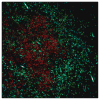Role of Foxp3-positive regulatory T cells during infection
- PMID: 18395860
- PMCID: PMC4052573
- DOI: 10.1002/eji.200738120
Role of Foxp3-positive regulatory T cells during infection
Abstract
Surviving an infection requires the generation of an immune response that controls the invading pathogen while limiting collateral damage to self tissues that may result from an exuberant immune response. Various populations of regulatory cells, including Foxp3+ Treg, have been shown to play a central role in the establishment of these controlled immune responses. In this review, I discuss current hypotheses and points of polemic associated with the origin, mode of action and antigen specificity of Foxp3+ Treg during infection.
Conflict of interest statement
Figures


References
Publication types
MeSH terms
Substances
Grants and funding
LinkOut - more resources
Full Text Sources
Other Literature Sources

